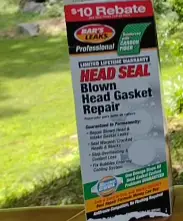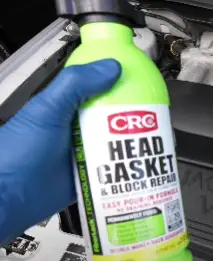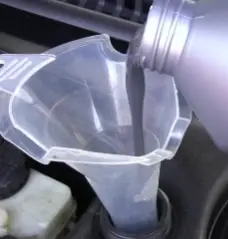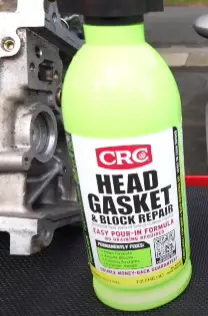Hey there, fellow car enthusiast! If you’re staring down the barrel of a blown head gasket and dreading the hefty repair bill, I’ve got something you need to check out: Fusion Head Gasket Sealer. I’ve been through the wringer with my old Chrysler 300C, and this stuff saved me from a $1200 repair job. It’s not just a quick fix—it’s a game-changer that can keep your engine running smoothly for years. In this article, I’ll share my personal journey, break down the pros and cons, compare Fusion to other brands, and give you tips to maximize its performance. Let’s dive in!
My Journey With Fusion Head Gasket Sealer

About a year ago, my 300C started acting up. White smoke was billowing from the tailpipe, the engine was running hotter than a summer day in Texas, and I could smell coolant where it shouldn’t be. My mechanic confirmed the worst: a blown head gasket. The quote? A jaw-dropping $1200. As a guy who loves his car but not the idea of emptying his wallet, I hit the internet for alternatives. That’s when I stumbled across Fusion Head Gasket Sealer, touted as the “world’s only 2-Part Flex-ePoxy sealer.” Skeptical but desperate, I decided to give it a shot.
I ordered the 8-cylinder kit, which arrived in two days with clear instructions. Following the steps, I drained the coolant, mixed the two-part formula, poured it into the radiator, and ran the engine for about 45 minutes. To my amazement, the white smoke stopped after a 30-mile drive, and the overheating vanished. It’s been a year, and my car’s still running like a champ. Fusion’s claim of a 6-7 year repair life seems legit, and I’m here to tell you why this product is worth your time and money.
Why Fusion Stands Out
Also Read: My Thought on Big Chill Fridge Reviews
Fusion’s 2-Part Flex-ePoxy formula is what sets it apart from the crowd. Unlike other sealers that rely on sodium silicate (aka water-glass), which can crack and clog your cooling system, Fusion uses a unique epoxy-polymer blend that stays flexible and bonds tightly to aluminum and cast-iron engines. It’s designed to tackle all symptoms of a blown head gasket—white smoke, overheating, coolant leaks, and even oil-coolant mixing. Here’s why I think it’s a cut above the rest:

- Unique 2-Part Formula: The epoxy-polymer mix creates a strong, flexible seal that doesn’t brittle like sodium silicate-based sealers. It’s built to last up to 6-7 years.
- Versatility Across Engines: Whether you’ve got a 4-cylinder Subaru or an 8-cylinder truck, Fusion has kits tailored for gas, diesel, and turbo engines.
- No Special Tools Needed: You don’t need to be a mechanic to use it. The instructions are straightforward, and you can apply it with basic tools.
- Long-Lasting Repair: My 300C’s been leak-free for a year, and online reviews suggest repairs can hold for 5-6 years or more.
- No Radiator Clogging: Unlike some sealers, Fusion doesn’t leave residue that clogs heater cores or radiators, keeping your cooling system clean.
- Works on Severe Leaks: It sealed my badly blown gasket, which was pushing coolant out of the overflow tank.
- Good Warranty: Fusion offers a solid warranty, giving you peace of mind if the product doesn’t perform as expected.
- Responsive Customer Support: Their team was quick to answer my questions when I called about application tips.
- Cost-Effective: At around $120, it’s a fraction of the $1000-$3000 cost of a full gasket replacement.
- Environmentally Safer: It’s free of harmful sodium silicate, reducing the risk of damage to your engine’s components.
This stuff isn’t just a band-aid; it’s a robust solution that gave my car a new lease on life. But it’s not all sunshine and rainbows—let’s talk about the downsides.
The Downsides Of Fusion Head Gasket Sealer
Also Read: My Thought on Big Chill Fridge Reviews
No product is perfect, and Fusion has its quirks. While it worked wonders for me, I ran into a few hiccups, and I’ve seen similar gripes in online forums. Here’s the lowdown on what you need to watch out for:
- Pricey Upfront Cost: At $120, it’s not the cheapest sealer out there. Budget-conscious folks might hesitate, but I found it worth every penny.
- Complex Application Process: Mixing the two-part formula and following the run cycles can be daunting if you’re not handy with cars.
- Thermostat Removal Recommended: For best results, you need to remove the thermostat, which can be a pain on some models.
- Not a Permanent Fix: While it lasts years, Fusion is still a temporary solution. Severe damage may require a full replacement eventually.
- Requires Patience: You might need to drive 30-50 miles over a couple of days for the seal to fully set, which can feel like a waiting game.
- Not Ideal for Minor Leaks: If your gasket has tiny cracks, cheaper sealers might do the job, making Fusion overkill.
- Availability Issues: It’s not always in stock at local auto shops, so you might need to order online and wait for shipping.
- Coolant Flush Needed: If you’ve used another sealer before, you’ll need Fusion’s Coolant Flush to clear out water-glass residue, adding to the cost.
- Oil Stop-Leak Add-On: If your gasket leak mixes oil and coolant, you’ll need to buy Fusion’s Oil Stop-Leak separately.
- Risk of Misapplication: If you don’t follow the instructions to a T, you might not get the full sealing effect, as some users reported.
Despite these cons, I found the process manageable, and the results spoke for themselves. Just be ready to put in a little elbow grease and follow the instructions carefully.
Fusion vs. Other Head Gasket Sealers
To give you a clear picture, let’s stack Fusion up against three popular competitors: BlueDevil, Steel Seal, and Bar’s Leaks. Each has its strengths, but here’s how they compare based on my research and experience.
Fusion vs. BlueDevil

- Formula: Fusion uses a 2-Part Flex-ePoxy, while BlueDevil relies on sodium silicate, which can crack in aluminum engines.
- Durability: Fusion claims 6-7 years of repair life; BlueDevil’s fixes often last 6 months to a year.
- Application: BlueDevil’s Pour-N-Go is simpler—just pour and drive—while Fusion requires mixing and multiple run cycles.
- Cost: BlueDevil is cheaper at $40-$70, but Fusion’s $120 price tag reflects its longer-lasting formula.
- Effectiveness: Fusion handled my severe leak; BlueDevil works better for minor leaks but can clog heater cores.
- Engine Compatibility: Both work on gas and diesel, but Fusion’s epoxy is safer for aluminum engines.
- Ease of Use: BlueDevil wins for simplicity, but Fusion’s instructions are clear if you’re patient.
- Warranty: Both offer money-back guarantees, but Fusion’s customer support was more responsive in my experience.
- Risk of Clogging: BlueDevil’s sodium silicate can clog radiators, while Fusion’s formula avoids this issue.
- Long-Term Value: Fusion’s higher upfront cost pays off with years of leak-free driving, unlike BlueDevil’s shorter lifespan.
Fusion vs. Steel Seal
- Formula: Steel Seal also uses sodium silicate, which is less durable than Fusion’s epoxy-polymer blend.
- Durability: Steel Seal lasted a month for one user I read about, while Fusion’s held strong for me over a year.
- Application: Steel Seal requires precise coolant-to-water ratios, whereas Fusion’s process is more forgiving.
- Cost: Steel Seal’s $60-$80 price is lower, but its effectiveness is hit-or-miss compared to Fusion.
- Effectiveness: Fusion tackled my white smoke and overheating; Steel Seal struggled with similar symptoms in reviews.
- Engine Compatibility: Both support multiple engine types, but Fusion’s safer for modern aluminum engines.
- Ease of Use: Steel Seal’s instructions are strict, while Fusion’s are detailed but easier to follow.
- Warranty: Steel Seal’s money-back guarantee is solid, but Fusion’s warranty felt more reliable based on my experience.
- Risk of Clogging: Steel Seal can clog cooling systems, while Fusion’s formula is designed to stay clean.
- Reputation: Fusion’s rated #1 by Motor Mechanics USA (2009-2023), giving it an edge over Steel Seal’s mixed reviews.
Fusion vs. Bar’s Leaks
- Formula: Bar’s Leaks uses a water-glass formula that’s prone to cracking, unlike Fusion’s flexible epoxy.
- Durability: Bar’s Leaks worked for 8 months for one user, but Fusion’s 6-7 year claim outshines it.
- Application: Bar’s Leaks is simple to pour, but it clogged a heater core in a forum user’s car, unlike Fusion.
- Cost: Bar’s Leaks is dirt-cheap at $15-$30, but you get what you pay for in terms of longevity.
- Effectiveness: Fusion fixed my severe leak; Bar’s Leaks is better for minor issues but less reliable for big problems.
- Engine Compatibility: Both work on various engines, but Fusion’s safer for aluminum and high-performance engines.
- Ease of Use: Bar’s Leaks is easier to apply, but Fusion’s detailed instructions ensure better results.
- Warranty: Bar’s Leaks has a limited warranty, while Fusion’s is more comprehensive.
- Risk of Clogging: Bar’s Leaks is notorious for clogging radiators, while Fusion avoids this issue.
- User Feedback: Fusion’s reviews are consistently strong, while Bar’s Leaks gets mixed feedback online.
Fusion comes out on top for durability and reliability, especially for severe leaks or aluminum engines. If you’re dealing with a minor leak and want a cheap fix, BlueDevil or Bar’s Leaks might do the trick, but for long-term value, Fusion’s my go-to.
Maintenance And Tips To Get The Most Out Of Fusion Head Gasket Sealer
Using Fusion is just the first step; maintaining your engine afterward is key to making that seal last. Here’s how I’ve kept my 300C running smoothly and some tips to help you get the most out of Fusion:

- Follow Instructions Precisely: The two-part formula needs to be mixed correctly. I measured carefully and followed the run cycles exactly as directed.
- Remove the Thermostat: If possible, take out the thermostat for faster sealing. I skipped this and still got results, but it took longer.
- Use Fusion’s Coolant Flush: If you’ve tried other sealers, flush the system with Fusion’s coolant flush to remove sodium silicate residue.
- Drive After Application: Drive 30-50 miles over a couple of days to let the sealer set. I noticed my symptoms disappear after about 40 miles.
- Monitor Coolant Levels: Check your coolant weekly for the first month. I topped mine off once to ensure the system stayed full.
- Use Oil Stop-Leak if Needed: If oil and coolant are mixing, add Fusion’s Oil Stop-Leak after the coolant-side repair. I didn’t need it, but it’s a lifesaver for some.
- Keep the Engine Cool: Avoid overheating during the sealing process. I let my engine cool if it hit 235°F, as advised for my Northstar engine.
- Check for Leaks Regularly: Inspect for white smoke or coolant loss for a few weeks post-application. I had no issues after the initial drive.
- Avoid Overloading the System: Don’t pour in more sealer than recommended. I stuck to the 8-cylinder kit’s dosage, and it worked perfectly.
- Call Customer Support if Needed: If symptoms persist after 48 hours, call Fusion’s support at (828) 656-3802. They helped me tweak my application.
By sticking to these tips, I’ve kept my car leak-free and running strong. Maintenance is minimal, but vigilance in the first few weeks ensures the seal holds.
Frequently Asked Questions (Faq)
In my experience, Fusion’s 2-Part Flex-ePoxy didn’t harm my engine. Unlike sodium silicate-based sealers, which can clog radiators or heater cores, Fusion’s formula is designed to stay flexible and clean. However, misapplication—like using too much sealer or not flushing prior sealants—can cause issues. Always follow the instructions to avoid problems.
K-Seal, a sodium silicate-based sealer, can work for minor leaks but carries a risk of clogging cooling systems, especially heater cores, as noted in online forums. I avoided K-Seal after reading about these issues. Fusion’s non-silicate formula felt safer for my aluminum engine, and I had no damage.
If your head gasket leak caused oil and coolant to mix, change the oil after using Fusion. I checked my oil and found it clean, so I skipped this step. If you use Fusion’s Oil Stop-Leak for mixed fluids, change the oil afterward to ensure the new seal works effectively.
Fusion’s instructions say to leave the sealer in the engine for up to 48 hours, with multiple run cycles and short drives (up to 5 miles each). I drove about 40 miles over two days, and the seal set perfectly. If symptoms persist, contact Fusion’s support for another application.
Conclusion: Why You Should Buy Fusion Head Gasket Sealer
Also Read: My Thought on Big Chill Fridge Reviews
If you’re facing a blown head gasket, Fusion Head Gasket Sealer is your ticket to avoiding a costly repair. My experience with it was a lifesaver—turning a $1200 nightmare into a $120 fix that’s still holding strong. It’s reliable, long-lasting, and safe for your engine. Don’t let a leaky gasket sideline your ride. Grab Fusion, follow the steps, and get back on the road with confidence. Check it out at fusionsealers.com and save your engine today!
